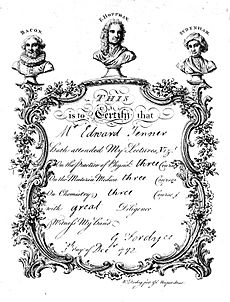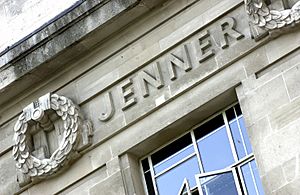Edward Jenner facts for kids
Quick facts for kids
Edward Jenner
|
|
|---|---|

Edward Jenner oil painting
|
|
| Born | 17 May 1749 Berkeley, Gloucestershire, England
|
| Died | 26 January 1823 (aged 73) Berkeley, Gloucestershire, England
|
| Nationality | British |
| Alma mater |
|
| Known for | Smallpox vaccine Vaccination |
| Scientific career | |
| Fields | Medicine/surgery, natural history |
| Academic advisors | John Hunter |
Edward Jenner (17 May 1749 – 26 January 1823) was an English physician known for creating the vaccine for smallpox. The practice of vaccination was popularized by Jenner, and since then has been used to prevent several diseases.
Jenner's work saved many lives. In his time, smallpox killed around 10% of the British population, with the number as high as 20% in towns and cities where infection spread more easily. In 2002, Jenner was named in the BBC's list of the 100 Greatest Britons.
Contents
Early life
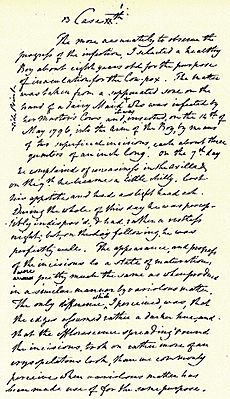
Edward Jenner was born on 17 May 1749 in Berkeley, Gloucestershire, England as the eighth of nine children. His father, the Reverend Stephen Jenner, was the vicar of Berkeley, so Jenner received a strong basic education.
Education and training
When he was young, he went to school in Wotton-under-Edge at Katherine Lady Berkeley's School and in Cirencester. During this time, he was inoculated (by variolation) for smallpox, which had a lifelong effect upon his general health. At the age of 14, he was apprenticed for seven years to Daniel Ludlow, a surgeon of Chipping Sodbury, South Gloucestershire, where he gained most of the experience needed to become a surgeon himself.
In 1770, aged 21, Jenner became apprenticed in surgery and anatomy under surgeon John Hunter and others at St George's Hospital, London. William Osler records that Hunter gave Jenner William Harvey's advice, well known in medical circles (and characteristic of the Age of Enlightenment), "Don't think; try." Hunter remained in correspondence with Jenner over natural history and proposed him for the Royal Society. Returning to his native countryside by 1773, Jenner became a successful family doctor and surgeon, practising on dedicated premises at Berkeley. In 1792, "with twenty years' experience of general practice and surgery, Jenner obtained the degree of MD from the University of St Andrews".
Later life
Jenner and others formed the Fleece Medical Society or Gloucestershire Medical Society, so called because it met in the parlour of the Fleece Inn, Rodborough, Gloucestershire. Members dined together and read papers on medical subjects. Jenner contributed papers on angina pectoris, ophthalmia, and cardiac valvular disease and commented on cowpox. He also belonged to a similar society which met in Alveston, near Bristol.
He became a master mason on 30 December 1802, in Lodge of Faith and Friendship #449. From 1812 to 1813, he served as worshipful master of Royal Berkeley Lodge of Faith and Friendship.
Zoology
Jenner was elected fellow of the Royal Society in 1788, following his publication of a careful study of the previously misunderstood life of the nested cuckoo, a study that combined observation, experiment, and dissection.
Jenner described how the newly hatched cuckoo pushed its host's eggs and fledgling chicks out of the nest (contrary to existing belief that the adult cuckoo did it). Having observed this behaviour, Jenner demonstrated an anatomical adaptation for it – the baby cuckoo has a depression in its back, not present after 12 days of life, that enables it to cup eggs and other chicks. The adult does not remain long enough in the area to perform this task. Jenner's findings were published in Philosophical Transactions of the Royal Society in 1788.
"The singularity of its shape is well adapted to these purposes; for, different from other newly hatched birds, its back from the scapula downwards is very broad, with a considerable depression in the middle. This depression seems formed by nature for the design of giving a more secure lodgement to the egg of the Hedge-sparrow, or its young one, when the young Cuckoo is employed in removing either of them from the nest. When it is about twelve days old, this cavity is quite filled up, and then the back assumes the shape of nestling birds in general." Jenner's nephew assisted in the study. He was born on 30 June 1737.
Jenner's understanding of the cuckoo's behaviour was not entirely believed until the artist Jemima Blackburn, a keen observer of birdlife, saw a blind nestling pushing out a host's egg. Blackburn's description and illustration were enough to convince Charles Darwin to revise a later edition of On the Origin of Species.
Jenner's interest in zoology played a large role in his first experiment with inoculation. Not only did he have a profound understanding of human anatomy due to his medical training, but he also understood animal biology and its role in human-animal trans-species boundaries in disease transmission. At the time, there was no way of knowing how important this connection would be to the history and discovery of vaccinations. We see this connection now; many present-day vaccinations include animal parts from cows, rabbits, and chicken eggs, which can be attributed to the work of Jenner and his cowpox/smallpox vaccination.
Marriage and human medicine
Jenner married Catherine Kingscote (who died in 1815 from tuberculosis) in March 1788. He might have met her while he and other fellows were experimenting with balloons. Jenner's trial balloon descended into Kingscote Park, Gloucestershire, owned by Catherine's father Anthony Kingscote. They had three children: Edward Robert (1789–1810), Robert Fitzharding (1792–1854) and Catherine (1794–1833).
He earned his MD from the University of St Andrews in 1792. He is credited with advancing the understanding of angina pectoris. In his correspondence with Heberden, he wrote: "How much the heart must suffer from the coronary arteries not being able to perform their functions".
Vaccination
Vaccination was a concept that was known before Jenner.
In 1765, Dr John Fewster published a paper in the London Medical Society entitled "Cow pox and its ability to prevent smallpox", but he did not pursue the subject further.
After 1770, at least five investigators in England and Germany (Sevel, Jensen, Jesty 1774, Rendell, Plett 1791) successfully tested a cowpox vaccine in humans against smallpox. For example, Dorset farmer Benjamin Jesty successfully vaccinated and presumably induced immunity with cowpox in his wife and two children during a smallpox epidemic in 1774. Jenner may have been aware of Jesty's procedures and success, but after Jenner's work some 20 years later the procedure became widely understood at last.
It was a common observation that milkmaids were generally immune to smallpox. Jenner thought that the pus in the blisters that milkmaids received from cowpox (a disease similar to smallpox, but much less virulent) protected them from smallpox. He may already have heard of Benjamin Jesty's success.
On 14 May 1796, Jenner tested his hypothesis on an eight-year-old boy, the son of his gardener. He scraped pus from cowpox blisters on the hands of a milkmaid. Jenner inoculated Phipps in both arms that day, subsequently producing in Phipps a fever and some uneasiness, but no full-blown infection. Later, he injected the boy with a mild form of smallpox and he showed no sign of infection. Jenner successfully tested his hypothesis on 23 more subjects.
Later life
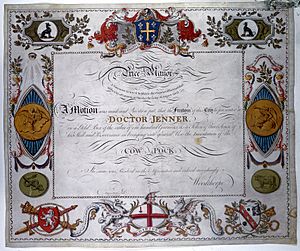
Jenner was later elected a foreign honorary member of the American Academy of Arts and Sciences in 1802, a member of the American Philosophical Society in 1804, and a foreign member of the Royal Swedish Academy of Sciences in 1806. In 1803 in London, he became president of the Jennerian Society, concerned with promoting vaccination to eradicate smallpox. The Jennerian ceased operations in 1809. Jenner became a member of the Medical and Chirurgical Society on its founding in 1805 (now the Royal Society of Medicine) and presented several papers there. In 1808, with government aid, the National Vaccine Establishment was founded, but Jenner felt dishonoured by the men selected to run it and resigned his directorship.
Returning to London in 1811, Jenner observed a significant number of cases of smallpox after vaccination. He found that in these cases the severity of the illness was notably diminished by previous vaccination. In 1821, he was appointed physician extraordinary to King George IV, and was also made mayor of Berkeley and magistrate (justice of the peace). He continued to investigate natural history, and in 1823, the last year of his life, he presented his "Observations on the Migration of Birds" to the Royal Society.
Jenner was a Freemason.
Death
Jenner was found in a state of apoplexy on 25 January 1823, with his right side paralysed. He did not recover and died the next day of an apparent stroke, his second, on 26 January 1823, aged 73. He was buried in the family vault at the Church of St Mary, Berkeley.
Monuments and buildings
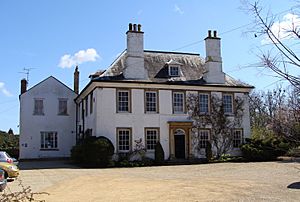
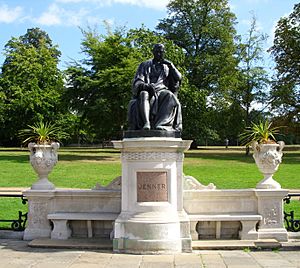
- Jenner's house in the village of Berkeley, Gloucestershire, is now a small museum, housing, among other things, the horns of the cow, Blossom.
- A statue of Jenner by Robert William Sievier was erected in the nave of Gloucester Cathedral.
- Another statue was erected in Trafalgar Square and later moved to Kensington Gardens.
- Near the Gloucestershire village of Uley, Downham Hill is locally known as "Smallpox Hill" for its possible role in Jenner's studies of the disease.
- London's St. George's Hospital Medical School has a Jenner Pavilion, where his bust may be found.
- A group of villages in Somerset County, Pennsylvania, United States, was named in Jenner's honour by early 19th-century English settlers, including Jenners, Jenner Township, Jenner Crossroads, and Jennerstown, Pennsylvania
- Jennersville, Pennsylvania, is located in Chester County.
- The Edward Jenner Institute for Vaccine Research is an infectious disease vaccine research centre, also the Jenner Institute part of the University of Oxford.
- A section at Gloucestershire Royal Hospital is known as the Edward Jenner Unit; it is where blood is drawn.
- A ward at Northwick Park Hospital is called Jenner Ward.
- Jenner Gardens at Cheltenham, Gloucestershire, opposite one of the scientist's former offices, is a small garden and cemetery.
- A statue of Jenner was erected at the Tokyo National Museum in 1896 to commemorate the centenary of Jenner's discovery of vaccination.
- A monument outside the walls of the upper town of Boulogne sur Mer, France.
- A street in Stoke Newington, north London: Jenner Road, N16 51°33′31″N 0°04′03″W / 51.55867°N 0.06761°W
- Built around 1970, The Jenner Health Centre, 201 Stanstead Road, Forest Hill, London, SE23 1HU
- Jenner's name is featured on the Frieze of the London School of Hygiene & Tropical Medicine. Twenty-three names of public health and tropical medicine pioneers were chosen to feature on the Keppel Street building when it was constructed in 1926.
- Minor planet 5168 Jenner is named in his honour.
Images for kids
-
Jenner performing his first vaccination on James Phipps, a boy of age 8. 14 May 1796
-
James Gillray's 1802 caricature of Jenner vaccinating patients who feared it would make them sprout cowlike appendages.
-
1808 cartoon showing Jenner, Thomas Dimsdale and George Rose seeing off anti-vaccination opponents
-
1825 memorial to Jenner by Robert William Sievier, in Gloucester Cathedral
See also
 In Spanish: Edward Jenner para niños
In Spanish: Edward Jenner para niños




